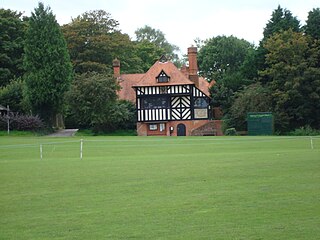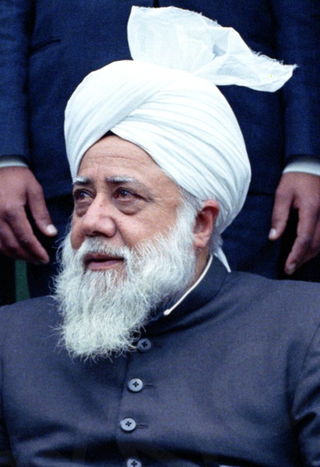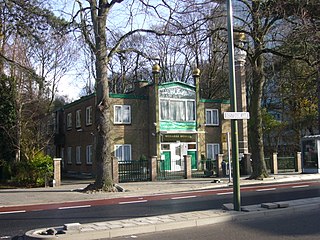Rabwah, officially known as Chenab Nagar, is a city in Chiniot, Punjab, Pakistan on the bank of Chenab River. It was the headquarters of the Ahmadiyya Muslim Community from September 20, 1948 when the community relocated from Qadian, India to the newly created state of Pakistan, where the Community leased the area of present-day Rabwah from the government to establish its home. This continued until 1984 and the establishment of Ordinance XX. In 1984, the headquarters were moved to the United Kingdom with Mirza Tahir Ahmed, first to London and then in 2019 to the Islamabad compound in Tilford, Surrey.

Tilford is a village and civil parish centred at the point where the two branches of the River Wey merge in Surrey, England, 3 miles (4.8 km) south-east of Farnham. It has half of Charleshill, Elstead in its east, a steep northern outcrop of the Greensand Ridge at Crooksbury Hill on Crooksbury Common in the north and Farnham Common (woodland) Nature Reserve in the west, which has the Rural Life Living Museum. As the Greensand Ridge in its western section is in two parts, the Greensand Way has a connecting spur here to its main route running east–west to the south.

The Baitul Futuh is a mosque complex of the Ahmadiyya Muslim Community, situated in Morden, London. It is one of the largest mosque complexes in Europe. Completed in 2003 at a cost of £15 million, entirely from donations of Ahmadi Muslims, the Mosque can accommodate a total of 13,000 worshippers. The main mosque has a height of 23m above ground, and to maximise capacity the building extends below ground. Baitul Futuh is located in the south-west London suburb London Borough of Merton. It is situated next to Morden South railway station, 0.4 miles from Morden Underground station and one mile from Morden Road tram stop.

Mirza Nasir Ahmad was the third Caliph of the Ahmadiyya Muslim Community. He was elected as the third successor of Mirza Ghulam Ahmad on 8 November 1965, the day after the death of his predecessor and father, Mirza Basheer-ud-Din Mahmood Ahmad.

The Fazl Mosque also known as The London Mosque, is the first purpose-built mosque in London, England. It was opened on 23 October 1926 in Southfields, Wandsworth. At a cost of £6,223, the construction of the mosque and the purchase of the land on which it stands, was financed by the donations of Ahmadi Muslim women in Qadian, Punjab, British India, with support from the British Muslim convert Khalid Sheldrake. Between 1984 and 2019 the Fazl Mosque was the residence of the caliphs of the Ahmadiyya Muslim Community, and therefore its de facto international headquarters. The administrative headquarters now lies at the site of the Islamabad, Tilford.

Mirza Masroor Ahmad is the current and fifth leader of the Ahmadiyya Muslim Community. His official title within the movement is Fifth Caliph of the Messiah. He was elected on 22 April 2003, three days after the death of his predecessor Mirza Tahir Ahmad.

The Mahmood Mosque, situated in Forchstrasse, Zurich, is the first purpose-built mosque in Switzerland. It is owned and run by the Ahmadiyya Muslim Community. The mosque has a minaret, the new construction of which is now banned in Switzerland by popular vote.

The Mubarak Mosque in The Hague is the first purpose-built mosque in the Netherlands. Its foundation stone was laid by Sir Muhammad Zafarullah Khan on 20 May 1955 who later inaugurated the mosque on 9 December 1955.

The Aqsa Mosque in Rabwah is the main and largest mosque of the Ahmadiyya Muslim Community in Pakistan. Its foundation stone was laid down in 1966. The mosque was inaugurated on 31 March 1972 by the head of the worldwide community, Mirza Nasir Ahmad. The building can accommodate up to 20,000 worshippers.

Ahmadiyya is an Islamic branch in Switzerland, under the spiritual leadership of the caliph in London. The Community was founded on October 13, 1946, during the late period of the Second Caliphate, when the caliph directed Shaikh Nasir Ahmad to establish a mission in the country. Today there are two Ahmadi mosques and 14 local branches, representing an estimated 800 Ahmadi Muslims.

Ahmadiyya, officially the Ahmadiyya Muslim Community or the Ahmadiyya Muslim Jama'at (AMJ) is an Islamic revival or messianic movement originating in British India in the late 19th century. It was founded by Mirza Ghulam Ahmad (1835–1908), who claimed to have been divinely appointed as both the Promised Mahdi and Messiah expected by Muslims to appear towards the end times and bring about, by peaceful means, the final triumph of Islam; as well as to embody, in this capacity, the expected eschatological figure of other major religious traditions. Adherents of the Ahmadiyya—a term adopted expressly in reference to Muhammad's alternative name Aḥmad—are known as Ahmadi Muslims or simply Ahmadis.

Jalsa Salana is a formal, annual gathering of the Ahmadiyya Muslim Community. It was initiated in 1891 by Mirza Ghulam Ahmad, the founder of the community, in Qadian, India. Usually, the gathering spans three days, beginning with the flag hoisting ceremony following the Friday Sermon. Although the convention held in the UK is deemed to be the major and 'international Jalsa' attended by Ahmadis from across the world, Ahmadis in other countries hold their own national Jalsas, sometimes attended by the Khalifatul Masih.

MTA1 WORLD or just MTA1 is the first television channel of the MTA International satellite network. It was launched on 1 January 1994 and was a continuation of AMP or 'Ahmadiyya Muslim Presentation'. After the launch of sister channels, the channel was renamed as MTA1. However, it is still loosely referred to as MTA or MTA International.

Daily Al-Fazl is one of the oldest dailies in the Indian subcontinent, an organ run by the Ahmadiyya Muslim Community. It was initiated by Mirza Basheer-ud-Din Mahmood Ahmad on June 18, 1913. The initial monetary responsibilities were fulfilled through donations by members of the community. The newspaper has been publishing the sermons, sayings and announcements of Ahmadiyya Caliphates for nearly a century. In Pakistan, the Al-Fazl was subject to the Pakistani law enforcement which suspended the publication of the newspaper for several months in 1984, and since 2015 it is not being published in Pakistan and has also shifted to Islamabad, Tilford in Surrey, England.

Ahmadiyya is a minority religion in Bangladesh. Although the first Bengalis to join the religion did covert during the lifetime of Mirza Ghulam Ahmad, the religion was first established as a community in the region of Bengal in 1913 by Syed Muhammad Abdul Wahed, during the Caliphate of Hakeem Noor-ud-Din. As the worldwide community is itself is an highly organised group under the Caliph, the national community works under the name Ahmadiyya Muslim Community Bangladesh or Ahmadiyya Muslim Jama'at Bangladesh. There are an estimated 100,000 Ahmadis in the country as of 2004.

The Ahmadiyya Muslim Community was established in United Kingdom with the pioneering efforts of Chaudhry Fateh Muhammad Sial, who arrived in London in July in 1913. Sial was the first missionary sent overseas by the Ahmadiyya Muslim Community and was under the direction of Hakeem Noor-ud-Din, the first caliph of the movement.

Our Teachings is an Urdu book published in 1902 by the founder of the Ahmadiyya movement, Mirza Ghulam Ahmad of Qadian, India. Mirza Ghulam Ahmad, a Messiah and Mahdi claimant, attempted to revive the purported original and pristine teachings of Islam. He entitled the book "Noah's Ark", implying that those who wanted to be saved from the deluge of irreligion and materialism should join the Ahmadiyya Muslim Community. Published in many languages, this English edition has been published by ‘Islam International Publications Limited’; Tilford, Surrey GUI0 2AQ. U.K. ISBN 1-85372-394-0] (1990)

Ahmadiyya is an Islamic community in Japan. The history of the Ahmadiyya Muslim Community in Japan begins after a number of mentions by Mirza Ghulam Ahmad, who showed a particular interest in introducing Islam to the Japanese people. The first Ahmadi Muslim missionary to be sent to Japan was Sufi Abdul Qadeer, who was sent by the second Caliph. He arrived in Japan on June 4, 1935. Today there is one purpose-built mosque, the largest in the country, representing an estimated 300 Ahmadi Muslims.

Islamabad, in the village of Tilford, Surrey, England, is an estate which serves as the headquarters of the Ahmadiyya Muslim Community. Islamabad is 10.4 hectares in area, where four hectares are used for headquarter buildings, offices and residential housing. It is the resting place of Mirza Tahir Ahmad, the fourth caliph of the community.














